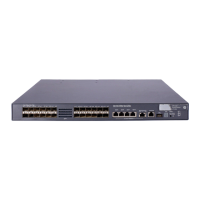6
Figure 3 The relationship between the protocol and screen output switch
1
3
Configuring system debugging
Output of the debugging information may reduce system efficiency. Administrators usually use the
debugging commands to diagnose network failure. After completing the debugging, disable the
corresponding debugging function, or use the undo debugging all command to disable all debugging
functions.
Output of debugging information depends on the configurations of the information center and the
debugging commands of each protocol and functional module. Displaying the debugging information on
a terminal—including console or VTY—is a common way to output debugging information. You can also
output debugging information to other destinations. For more information, see Information center
commands in the Network Management and Monitoring Command Reference. By default, you can output
debugging information to a terminal by following these steps:
To do…
Use the command… Remarks
1. Enable the terminal
monitoring of system
information.
terminal monitor
Optional.
The terminal monitoring on the
console is enabled by default and
that on the monitoring terminal is
disabled by default.
Available in user view.
2. Enable the terminal display of
debugging information.
terminal debugging
Required.
Disabled by default.
Available in user view.
3. Enable debugging for a
specified module.
debugging { all [ timeout time ] |
module-name [ option ] }
Required.
Disabled by default.
Available in user view.

